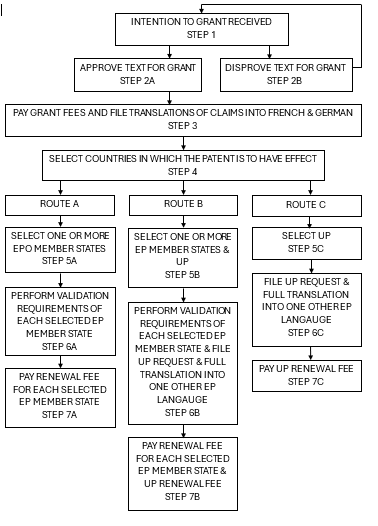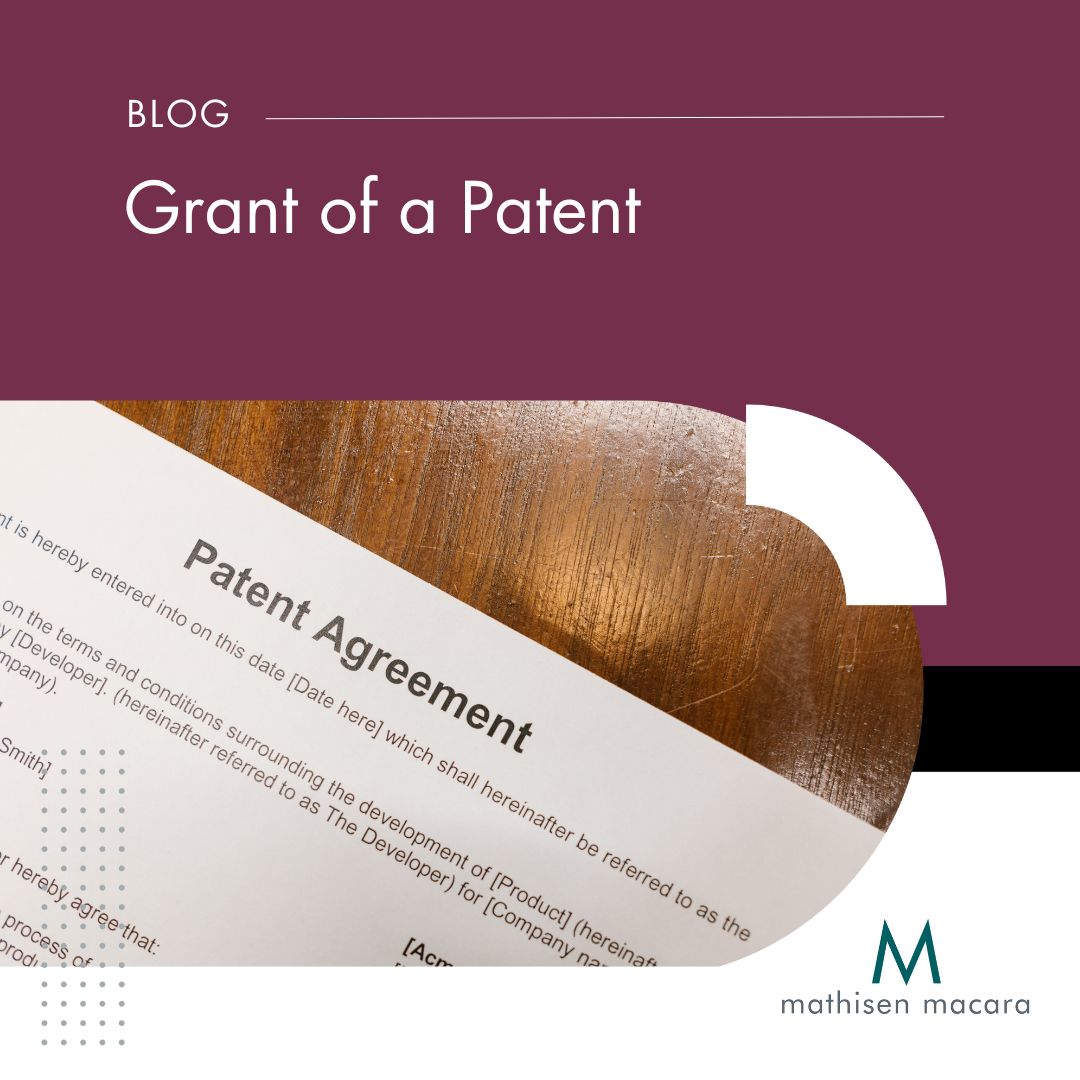EPO Grant of a Patent
So, you’ve received an Intention to Grant from the European Patent Office – what do you need to do now?
The grant process at the European Patent Office can be a little complicated, with a number of different options available. With the aid of the attached diagram. this article aims to explain these options to help you make an informed decision.
What is an Intention to Grant?
Once the examining division at the European Patent Office are happy that your application meets the requirements for patentability, they will issue an Intention to Grant communication pursuant to Rule 71(3) of the EPC, accompanied by the text of your application as proposed for grant.
What do you need to do to complete the grant process at the European Patent Office?
To begin with, you must review the text proposed for grant by the Examiner. If you are happy with the text proposed, then you must approve the text (at step 2A), file translations of the claims into French and German (assuming your application is in English) and pay the grant fee (step 3). Your application will NOT grant if steps 2A and 3 are not taken.
If you do not agree with the text proposed for grant, then you can disapprove the text by filing a response, suggesting an alternative text for grant (step 2B). If the Examiner agrees with your suggestions, another Intention to Grant communication will be issued and the above-outlined steps must then be taken.
Once the text has been approved, the translations filed and the gran fee paid, you will need to decide what kind of European patent you would like to receive.
What options are there for validation post-grant?
A “traditional” European patent is essentially a bundle of national patents. It is necessary to validate the European patent in the countries in which you require the European Patent to have effect. With the traditional European patent, you choose the particular European countries where you would like to obtain protection, and these patents are maintained or abandoned individually.
However, it is also now possible to select a European Unitary Patent (UP), which is a single patent that covers all of the signatory states. It is not possible to select particular countries within the UP. A UP covers all signatory states and is maintained or abandoned for all states as one.
A “traditional” European patent can have effect in 39 European countries, namely:
Albania ; Austria; Belgium; Bulgaria; Cyprus; Czech Republic; Denmark; Estonia; Finland; France; Germany; Greece; Croatia; Hungary; Ireland; Iceland; Italy; Latvia; Liechtenstein; Lithuania; Luxembourg; Malta; Monaco; Montenegro; the Netherlands; North Macedonia; Norway; Poland; Portugal; Romania; San Marino; Serbia; Slovakia; Slovenia; Spain; Sweden; Switzerland; Turkey; and the United Kingdom.
A European Unitary Patent currently covers 18 European countries, namely:
Austria, Belgium, Bulgaria, Denmark, Estonia, Finland, France, Germany, Italy, Latvia, Lithuania, Luxembourg, Malta, Netherlands, Portugal, Romania, Slovenia, and Sweden.
You will see that not all of the countries covered by the traditional European patent are covered by the European Unitary Patent. Therefore, it may be necessary to have both a European Unitary Patent and some “traditional” European national patents to obtain the cover you require.
If you require your European application to become a patent in one or more of the “traditional” European countries (step 5A), then it is necessary to perform the required validation step for each country. Some countries do not have any requirements. Belgium, France, the United Kingdom, Germany, Switzerland and Liechtenstein, Ireland, Luxembourg and Monaco, do not have any requirements so if no action is taken, then your European Patent will take effect in these countries automatically on grant. You will though need to pay renewal fees in those countries to maintain these patents.
Other countries do have requirements and may require:
- translations of the claims into one of their official languages;
- a full translation of the patent into one of their official languages;
- payment of a validation fee (for publication of the translation); and/or
- a local attorney be appointed as address for service.
Once you have selected the countries you require, we can inform you of the validation requirements.
After being validated, in the one or more countries (step 6A), your European patent is treated as a national patent in each validated country and must be maintained individually, by paying the renewals fee to each country (step 7A).
If you require your European patent to become a UP (step 5C), then all 18 countries of the UPC will be covered by the UP patent. In order to select a UP, a request must be submitted and a full translation of the patent into one of the other languages of the EP must be filed (step 6C). Only one renewal fee is required to be paid (step 7C) in order to maintain the UP patent in all 18 countries. Generally speaking, if you require your European application to become a patent in four or more of the countries signed up to the UPC Agreement, then it is financially advantageous to request a UP rather than separate national validations. However, you should remember that a UP can only be maintained or abandoned as a unit.
If you require your European application to become a patent in some of the “traditional” EP countries which have not signed up the UP, as well as becoming a UP (step 5B), then your application needs to be validated separately in the “traditional” EP countries in addition to filing the request for a UP (step 6B).
For example, if you require your European Patent to have effect in the UK, Spain, France, Germany, Italy, and Portugal, then you can either select to validate your patent in each country separately (using route “A”), OR you can select a UP (which will cover all 18 UP countries, which includes France, Germany, Italy, and Portugal) and individually validate your European patent in the UK and Spain (using route “B”). Since Spain requires a full translation for validation, the Spanish translation can also be used for your UP.
The particular validation route that works best for you may not be the same for each of your patents. Our European patent attorneys are happy to discuss the different options with you to help you decide which route is likely to be commercially most effective for your patent. If you require assistance with your European patent applications, please do not hesitate to contact us.

